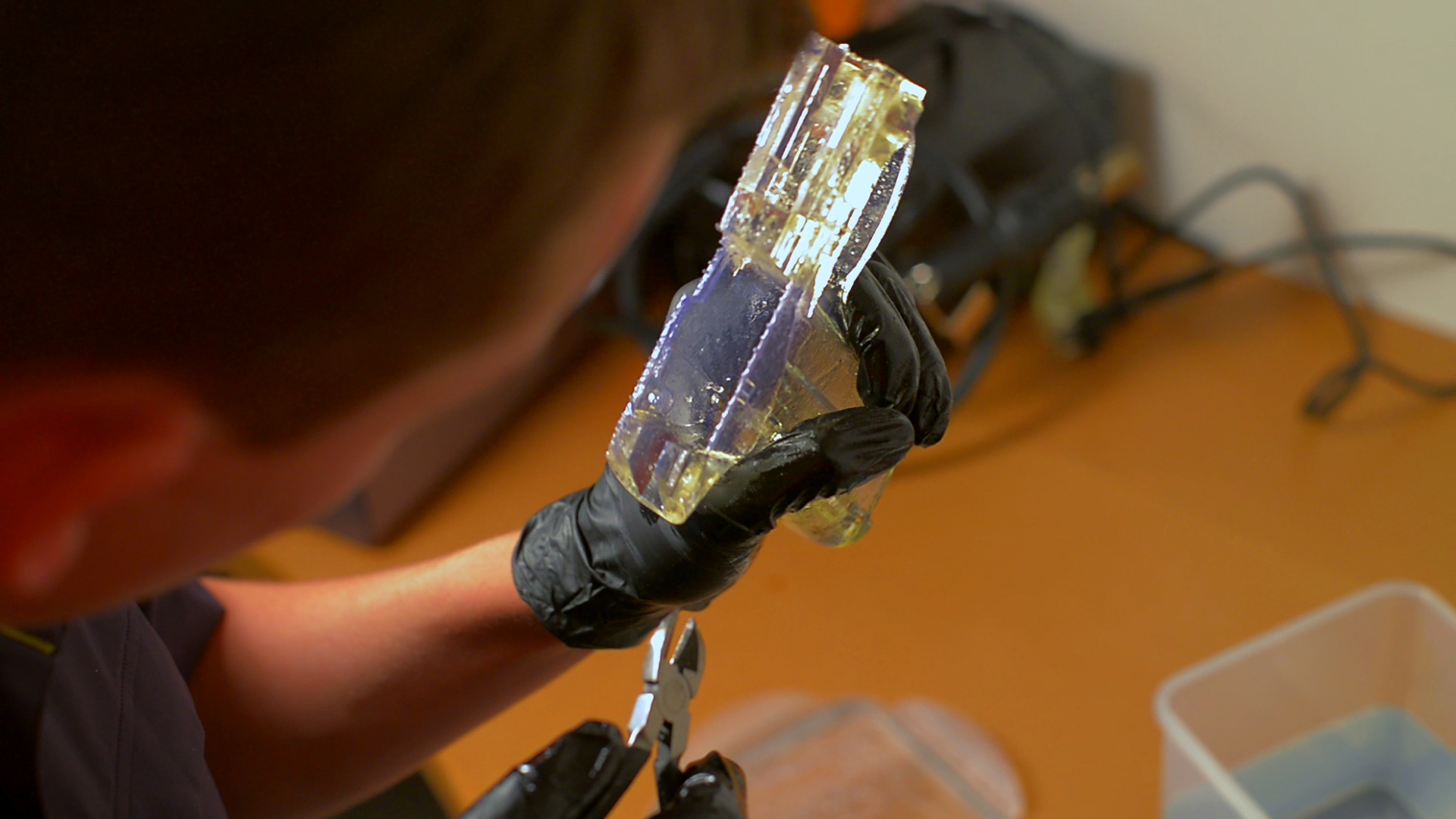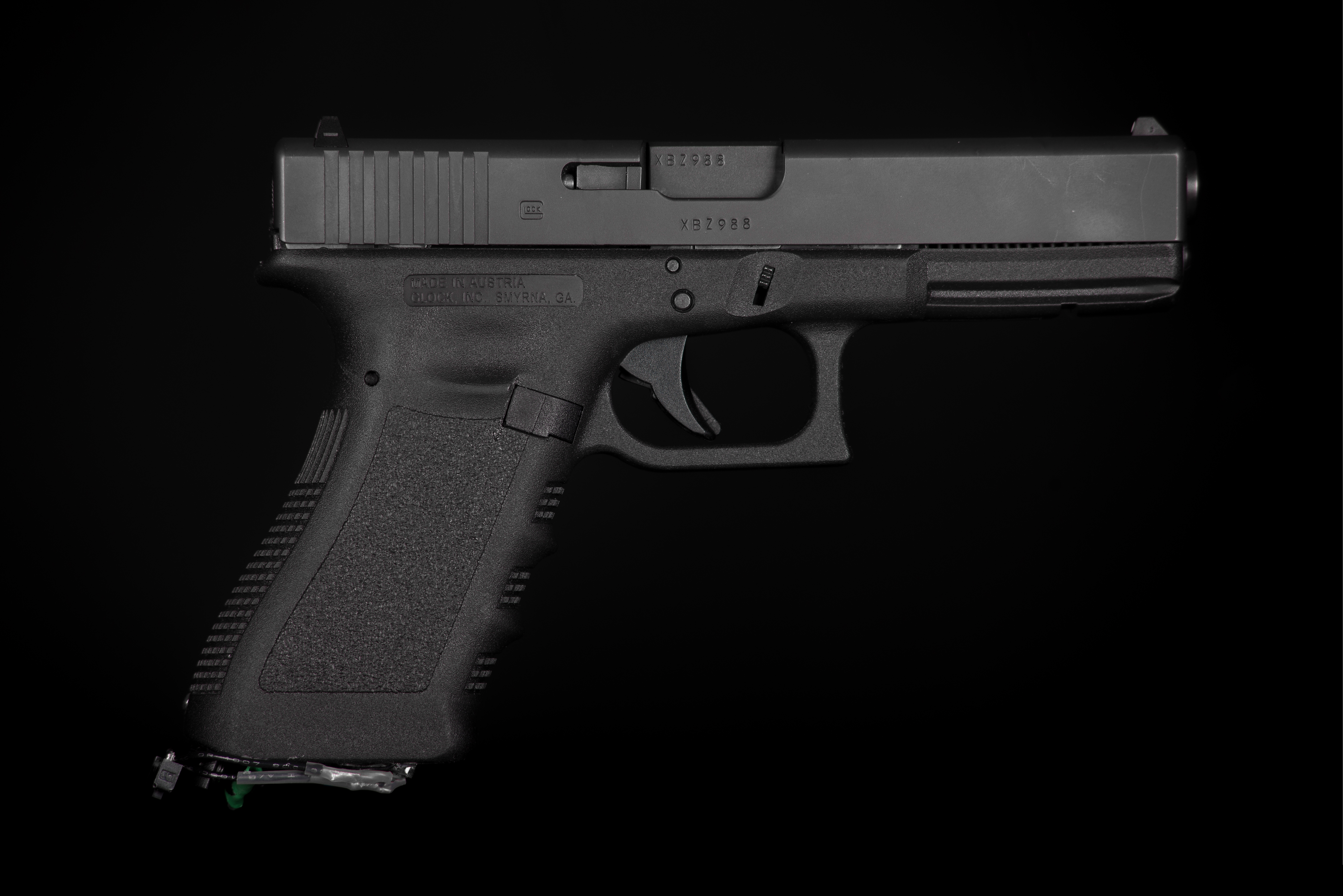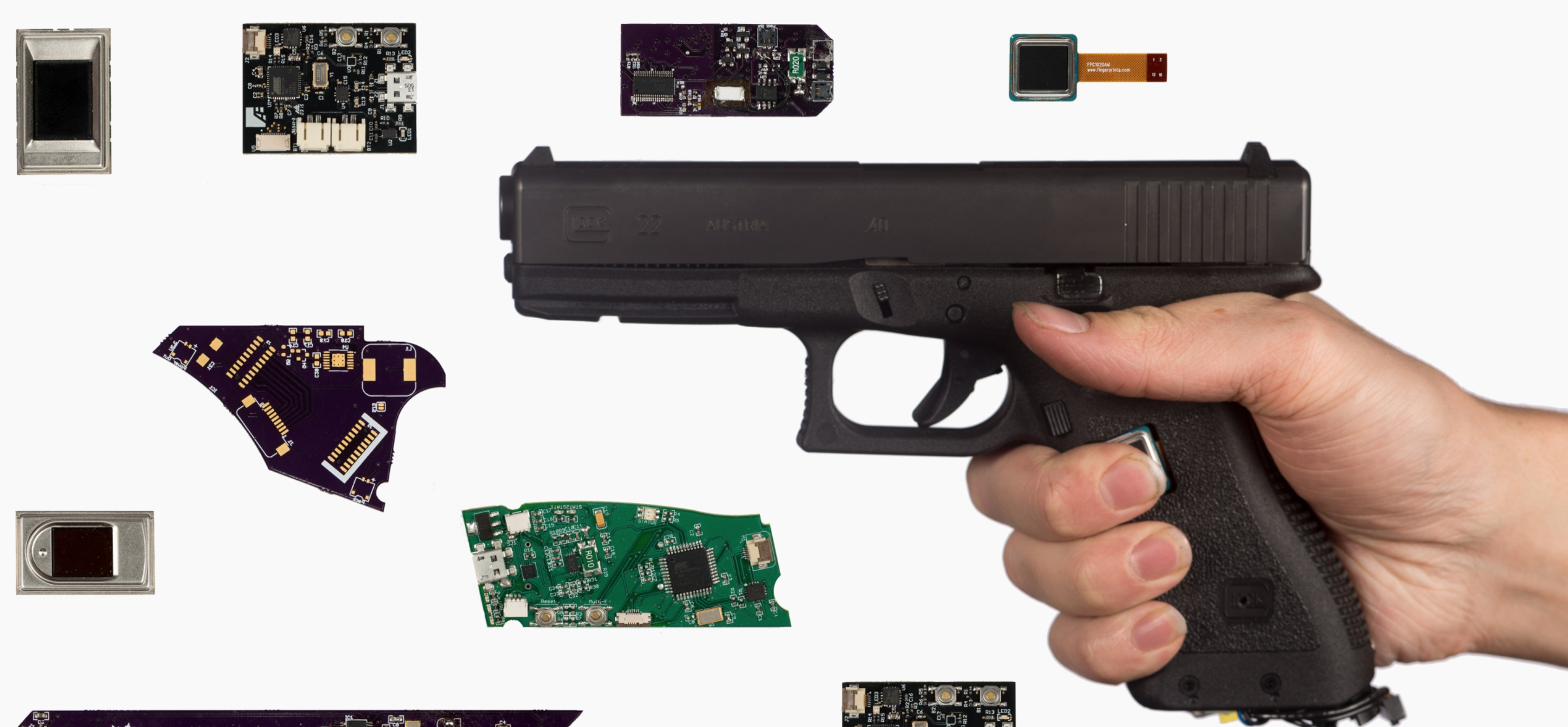
Gun violence doesn’t seem to be going away any time soon. Whether the shooting is racially charged, gang-related, domestic terrorism, self-defense, or self-inflicted, guns, in the wrong hands, are the harbingers of tragedy. The fight over firearms is a confusing one (there are people who profit from this confusion, naturally), and includes all sorts of nuance. Alas, the tactic of “letting the conversation cycle without doing much of anything” hasn’t proven productive, either. What we need, as a nation, are thought leaders eager to come to the table with solutions.
Kai Kloepfer — who UPROXX interviewed in 2015 when he developed a concept for a “smart gun” — is just such a problem solver. As a high school student, he dreamt up a gun that utilized fingerprint recognition, much like modern iterations of the iPhone. When the gun found the wrong hands, it would be rendered completely useless. Accidental shootings would plummet.
Since the original video went viral, Kloepfer has started college at MIT while continuing work on the “smart gun.” We decided to check in with him to see how much he’s progressed, hear about his tech company Biofire, and discuss the future of “safe” firearms.
I’ve been around guns my whole life because I’m from Texas. But, what intrigues me the most about yours is the idea that guns are more or less personalized. There’s only one person that can use a gun a specific gun.
It’s like your iPhone. So you can add a trusted friend a spouse anything like that to it as well.
The last time you spoke to UPROXX, you said that your goal was to finish your live firearm prototype in 2015 and graduate from high school. The graduating thing probably was a cinch. How has it been with your firearm prototype?
I definitely did not finish the prototype in 2015. It took a little bit longer than expected, but it’s all working out. Basically, what happened there was after high school I took a year off to work on my company. And, during 2015/2016 the main thing we were doing was trying to push forward to that Live Fire prototype. So, when you first interviewed me earlier on I had a plastic model of a smart gun and all the technology and stuff incorporated into a 3D printed piece of plastic, which provided the idea but was not a product, obviously.
The next step there was taking that technology and morphing it into an actual firearm, instead, in a way that worked. I finished that pretty much near the end of my gap year, right before I went to MIT. So… that would’ve been mid-2016, I think, and we launched that with a big article in the Wall Street Journal and stuff like that when we had the technology incorporated into an actual firearm. It worked, but there’s definitely quite a bit of work to be done over the next year or so, maybe a year and a half to work out building up Biofire’s team, building up Biofire as a company, and really taking this product to market.
I was on your website as well. It mentioned the smart guns’ specific mandates and law like that. How would you say that they should differ from the gun laws that people are trying to get put in place or the ones that we have right now?
The way that we view gun laws at Biofire is that we’re neutral in terms of general sort of gun laws. And, I think that overall, our goal is to protect that balance and there’s a logical way to do that. I think there are some gun laws that make sense and there are some that don’t. But basically, those should affect all firearms the same way, whether they’re smart guns or not. What we’re opposed to is laws that specifically target just smart guns.
For example, there’s a law in New Jersey that 18 months after a smart gun is available all firearms sold in the state of New Jersey have to be smart guns. We’re opposed to things like that because I don’t think it makes any sense to mandate a single product across an entire market instead of offering a bunch of different options to consumers. What we’re trying to do is really create an option that could be better for some kinds of gun owners. But, it’s not a replacement for every gun out there. So, we’re opposed to laws that specifically target smart guns right now just because I think we need to get a better sense of what even a smart gun is and who uses them and stuff like that long before legislation makes any sense.
So if I were to sell smart guns what kind of consumer would I be looking at?
There are a couple of different ways to look at that. The approach that we’re taking is we’re building a smart gun primarily for people who use firearms indoors and at the shooting range, so these are maybe not your biggest sort of most enthusiastic gun owners, but more people who own a firearm or two for self-defense, to protect themselves and family. And, we’re focusing on those users because that’s where we see a lot of accidents happening, and that’s where we see potentially the most opportunity for innovation in the short run.
In the long run, smart guns — and this wouldn’t necessarily be the same smart gun, but smart guns in general — have application in a lot of different areas. Both with what I just talked about but also with law enforcement, military, private security, prison officers, air marshals, sort of that whole group of users. It’s probably a different product, but there are a lot of issues with those kinds of professional customers where they’re worried about officer take away — people getting firearms away from law enforcement officers. So, we want to make sure that that’s a potential area, as well. Which one you pursue first and how you go about it [is a matter of] choosing to do the thing that makes the most sense.
Right now, we’re starting primarily with people who are using their firearms indoors at shooting ranges using them for self-defense to protect their families.

So, we’ve had some stores get put on blast about selling guns to people and not effectively checking their backgrounds. Do you think the very existence of smart guns will help better regulate the number of people getting guns who are not supposed to have them at all?
Probably not very much. The areas where we see smart guns having the most effect are, from a social perspective, accidental gun death and suicide — situations in which people are accessing firearms without the owner’s permission. So, any situation where, for example, a teenager got a hold of a gun and tries to commit suicide. Or, a toddler has found a gun and doesn’t even know what he or she and is playing with it. Situations like that we can definitely prevent. Or, you know somebody has broken into your house and takes your gun away from you. We can make sure that they’re not going to be able to use it. However, we’re not claiming to stop things like illegal arms trafficking or firearms theft or things like that.
There’s nothing inherent about our product that would make it “less gettable” or anything like that. It would make it a little harder for your average sort of petty thief. But, we’re not claiming that organized crime would not be able to rip the smart part out of the gun and just turn it back into a normal gun.
It’s about avoiding accidents or misuse, above everything.
Yeah, exactly. We’re using fingerprints, but were not using fingerprints to identify users with databases. So, you purchase our gun any way you would normally, and the fingerprints are used the same way they are on your iPhone, where the owner can put their fingerprint in and as long as they’re the owner it’s just a tool that we’re using to make sure they’re the same person. We have no idea who that owner is. There’s no way that we are connecting to that. We’re not looking their fingerprints up anywhere. We can’t even do that. So, as long as they can legally buy a gun to start with then they’ll be able to buy a smart gun.
Okay, and what kind of technology does it come with? Is it all within the gun like it is in our phones? Or is it like a separate kind of thing that you have to do with your computer?
Nope. It’s entirely internal. So, you said you were on our website, and there’s the photo on the front page of our Live Fire prototype. That’s what it looks like. There no external cords or computers or anything like that – it’s all built inside the gun. And, it’s very much contained. We’re trying to make it as simple as possible to use. So, it’s just a push button, [and] if you want to add new users, you have to authenticate your fingerprint and then you can add somebody else. But, it’s really designed to be very, very simple.
Honestly, it’s designed to be more like a toaster than a smartphone. You know, something that anybody can use, anybody can figure out. It shouldn’t be any harder to use than a normal gun. If you know how to properly use a firearm then you should be able to use a smart gun.
One thing I thought was fascinating, I guess just from using other electronics…your battery life is a year. How?
That sort of goes back a little bit to the toaster versus smartphone thing. There’s a lot of fun engineering going on in the background. But on a higher level, there a number of devices out there that sort of have multiyear battery life, which is like coin cells. I don’t know if you’ve seen the class of wireless trackers — the tile-like devices that you attach to your keychain that help you find your phone later. Things like those are running off a little coin cell batteries and the have year-long battery life. And, honestly, in some ways, those are more power intensive then what we’re working on. So, the thing is, we’re not a smartphone. We’re not running apps, we don’t have a display, there no wireless communication…there’s no cell service. All the things that really take up the vast majority of the power in a lot of our modern electronic devices, we don’t have. We’ve done a lot of engineering work to make sure that the gun only uses very, very, very small amounts of power when not being used. So, if it’s sitting in a drawer somewhere you know it’s just taking little tiny sips of power.
That allows us to get that yearlong battery life with a relatively small battery, but bigger than a coin cell.
What about price point? Is this something that your toaster buyers could buy?
What we’re looking at is making it affordable for people that are would already be buying a comparable quality of handgun. If it was a “dumb gun,” it would cost around $600. We’re looking at building about an $850 markup. That’s highly subject to change, and we’ll have to see what the final price ends up at. But, definitely under $1000, and we want to make sure that it’s an option for people where it could cost about the same as buying a regular gun. We want to make sure that it’s affordable — the Armitrix iP1 system, which was the only other smart gun that was ever really released, wasn’t a very good product, but it cost about $3000. That’s just not affordable for most people. Whereas, we think that under $1000 is much more reasonable.

Do you have plans to make any other kinds of like any other classes of guns with this smart technology? Are you going to have your shotgun, your rifle, etc.? Do you plan to branch out or is this kind of your lane here?
Good question. In the short run, we are focusing primarily on handguns and probably that sort of palm or frame striker fired handgun that you saw on our website for a number of different reasons. From a social perspective, the vast majority of accidents and suicides…you know, we have 2000 firearm suicides in the U.S. every year. Over two-thirds of all gun deaths are suicides. So that’s the vast majority of those are using handguns. People don’t try and commit suicide with rifle or shotguns. Not that it’s never happened but it’s very, very uncommon comparatively. But, from more of just an intuitive perspective, and talking with consumers talking with our users — people don’t seem to leave rifles lying around quite the same way they do or other long guns the way they do handguns.
You know, if you put a AR 15 in the corner… it’s kinda obvious. People don’t just tend to forget about it. Whereas, a handgun has become such a sort of normal thing in our society that people just put them in their nightstand drawer and kinda forget they’re there. So, to start with, we’re focusing on a handgun for the foreseeable future. But the technology is definitely applicable to rifles. That would be substantially easier to do with a rifle or a long gun just because of the amount of space that available inside the firearm. [With] a handgun we have to fight for sort of every cubic millimeter where a rifle socket has tons of extra space in it so it wouldn’t be too hard to do if our technology progresses.
Got you. Is there anything else that you would want prospective buyers to know or people like us that have been following this story?
There quite a few things we’re definitely continuing to work toward the technology, and we’ll keep you updated as we make the progress. You know, it’s a bit of a slow road, but we’re doing it. Hopefully, in the next 12-ish months, we’re going to have a product on the market. Maybe a little bit longer than that. People can feel free to reach out to us and ask questions or just get in touch with us. We’re continuing to do exciting things and getting closer and closer. That’s definitely a good thing.






